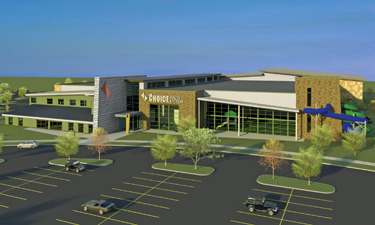 Nearly all of Grand Forks, North Dakota, was evacuated in 1997 because of severe flooding. The physical devastation was on a grand scale, as was the economic and emotional toll of this disaster. But rebuilding the town became an opportunity for new partnerships and a new vision for the community. When local leadership had the opportunity to come together to tackle community health by making improvements in the infrastructure and environment of Grand Forks, those leaders understood the value of partnership.
Nearly all of Grand Forks, North Dakota, was evacuated in 1997 because of severe flooding. The physical devastation was on a grand scale, as was the economic and emotional toll of this disaster. But rebuilding the town became an opportunity for new partnerships and a new vision for the community. When local leadership had the opportunity to come together to tackle community health by making improvements in the infrastructure and environment of Grand Forks, those leaders understood the value of partnership.
The information-gathering stage of this project began with number crunching. If 30 percent of the population will use an indoor recreation center during the winter, how many square feet of center would be needed in Grand Forks?
An aging YMCA center provided indoor recreation opportunities for city residents. This site was focused on families, offering classes and opportunities for recreation to people of all ages. However, the site was small and looking worn. The community could support an additional wellness center, but it would compete with the YMCA, potentially diverting funds from this important local landmark and alienating a set of key community stakeholders.
A partnership that originated following the aftermath of the 1997 flood developed a plan to build a new wellness center south of Grand Forks. This site would be large and modern, offering indoor courts, classes, and a hockey rink. With a strong desire to build this facility without using tax revenue, the team committed to a (successful) $22 million capital campaign.
The work of the collaborative focused on how to create a workable, and profitable, plan for the two centers (the YMCA and the new center run by the City Parks and Recreation Department) to exist as true partners. The CEOs of both groups decided that offering reciprocal membership to both clubs was the answer. Once the new building is complete, people in Grand Forks can now use either the YMCA site at the north end of town, or the new city site on the south end. Membership at one center is membership at the other.
This remarkable partnership came out of tragedy, and was possible through a clear and compelling vision to create an infrastructure for health and wellness as well as economic development for the region. It also required diligent work to remain engaged, and to remain committed to a collaborative process. Grand Forks turned this vision into reality because of the hard work of volunteers and local leaders. The power of commitment to the cause of a healthy infrastructure and for local coordination can be fueled by the success of the shared wellness centers.
Erika Lehmann and Nicole Oehmke are with Smith and Lehmann Consulting. For more information, contact Zarnaaz Bashir, MPH.

